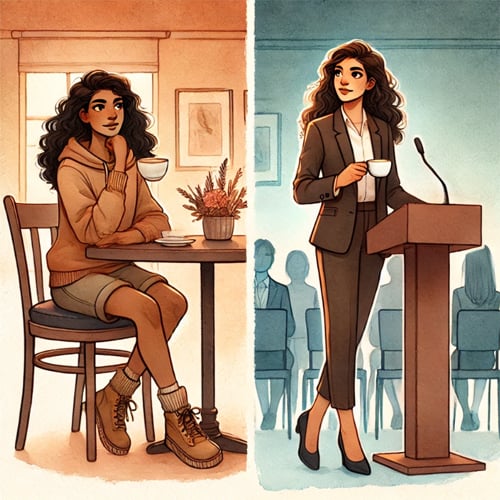🥄 Casual or Formal? Use the “Coffee vs Conference” Scale to Get the Tone Right

Hello, Hello!
If I asked you to explain how addition works to a 5-year-old, would you use the same words you'd use with a 25-year-old? Probably not. A child doesn’t have the same reference points or life experience to grasp math the way an adult would.
The same applies to your professional communication. People from different industries, departments, or cultural backgrounds won’t interpret technical topics the way you do. What makes perfect sense in your world might sound like noise in someone else’s.
It's tempting to share the same message with everyone to save time. But when you do that, you risk confusing half the room and walking away frustrated that no one “got it.”
Today, we’re talking about one powerful mindset shift: tailor your message to match your audience—not the other way around.
Enjoy,
— Aderson
🥄 Casual or Formal? Use the “Coffee vs Conference” Scale to Get the Tone Right
Have you ever hit "send" on a message and immediately thought, “Oops… that sounded too stiff,” or worse, “That was way too casual”? You're not alone.
Tech professionals often get stuck using the same tone for everything—Slack messages, client emails, documentation, presentations. But here's the truth: one tone doesn’t fit all. If you talk to your CTO like you're chatting with your gym buddy, it may not land. And if your coworker asks for help and you reply like you're delivering a keynote, you’ll sound robotic.
So, how do you strike the right tone?
Start with a simple rule: think in terms of coffee vs conference.
☕ The “Coffee vs Conference” Scale
This scale helps you calibrate your communication based on how casual or formal the context is:
- A Slack message to your teammate? That’s coffee.
- A presentation to executives? That’s conference.
- An email to a new client? Somewhere in between.
Let’s break this down into three key points:
📶 Start by Reading the Room
Before you even type, ask: Who is this for, and what's the context?
- If you’re in a one-on-one with someone you speak to daily, go conversational.
- If it’s a big update to the entire department, shift your tone to something more structured and polished.
- Match the tone of the channel too: Slack is not Outlook. A voice message to a friend isn’t the same as a status report.
Tone isn’t about faking it—it’s about being effective. The best communicators don’t use one voice for everything. They adjust based on who’s listening.
🎛️ Use a Tone Dial, Not a Switch
Tone isn't either casual or formal—it’s a spectrum. Picture a dial with “Coffee Chat” on one end and “Conference Keynote” on the other.
- “Hey, just a heads up that I pushed the fix” → Casual
- “The issue has been resolved. Let me know if you need anything else.” → More formal
Neither is wrong—it depends on who you're talking to. When in doubt, start slightly more formal and adjust from there as the relationship builds.
🔁 Mirror and Adapt
People often give you clues about how they like to communicate. Pay attention to how others write or speak.
- Do they use emojis? Short sentences? No caps? That’s Coffee.
- Do they use full sentences, structured paragraphs, or open with greetings like “Good morning”? That’s leaning Conference.
You don’t need to copy them exactly, but adjusting slightly in their direction builds trust. Think of it as respectful flexibility.
📌 Final Thoughts
Tech professionals often pour so much energy into what they say that they forget to consider how they say it. But the delivery matters. If your tone doesn’t match the room, your message can get lost—even if the content is solid.
The “Coffee vs Conference” scale is a mental tool to help you navigate tone, one conversation at a time. With a little awareness and a few tweaks, you’ll notice people respond faster, more positively, and with fewer misunderstandings.
"Wise men speak because they have something to say; fools because they have to say something." — Plato